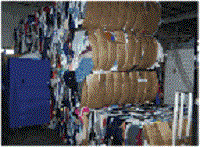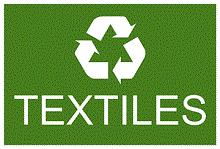 |
TEXTILE RECYCLING GUIDELINE!
By Patricia Griffin, President, GHA
When attempting to do a brief phone survey asking what happens to a hotel�s retired bed and bath linens, I got a response that was essentially �it�s against our brand�s policy. Our brand does not allow anything paid for by the hotel to be sold or given away� implying that it could/would be negative for the brand�s reputation. The lady said the retired linens were used as cleaning rags, perhaps dyed black and �completely used up before they were thrown away.� She said, �No one would have any use for what is thrown away.� Yet, we know textile wholesalers would love to have those linens unless they�re greasy, very dirty or covered in paint.
At least 95% of all textiles are recyclable, but currently only 15% of textiles are actually recycled. In my 20 years of working with greening hotels, I believe this huge, almost invisible textile industry has been operating under the radar screen too long. We need to educate and inform hoteliers that their retired bed and bath linens have value and can be sold, or, minimally, shipped at no cost to a recycler.
Green Hotels Association has been instrumental in getting American Hotel & Lodging Association to add the following guideline to their website at ahla.com/Green.aspx?id=36228.
Implement a Textile Recycling Program
Each year, a typical hotel recycles over one million pounds of standard recyclables such as cardboard, glass, metal and plastics as well as hazardous materials such as fluorescent bulbs, batteries and lighting ballasts. An overlooked component to any hotel recycling program may be recycling textiles. 95% of all textiles are recyclable, but only about 15% of textiles are currently being recycled in the US according to the US EPA.
Post-consumer textile recycling is one of the oldest, most efficient recycling industries in existence. Textile recyclers add tremendous value through the labor-intensive sorting, separating and recycling of second-hand textiles into three main categories: fibers; reclaimed wipers; and used textiles. For hoteliers, textiles can be bed linens, sheets, pillow cases, towels, comforters, blankets, napery, and curtains. In terms of value to hoteliers, they may only be paid for certain more desirable items such as sheets and towels. But there is savings from not disposing of these items by sending them to a landfill.
 What happens to recycled textiles?
What happens to recycled textiles?
What can be done with these textiles when you replace them? Sheets, pillow cases; bath, wash, hand and kitchen towels along with cotton or cotton-blended table linens may be used to make industrial wiping cloths. Other textiles such as bed spreads, comforters, and curtains might be used in developing nations for the same purpose, but in a home setting. Many of the world�s poor live on just a few dollars a day and low-cost textiles for the home are desirable. If any of the textiles cannot be used for their intended purpose or if they are not suitable for wiping cloths, the textiles can be processed by a textile recycler into fiber. This grinding process shreds the material into tread-like yarn. This material is then formed into insulation for automobile sound proofing, carpet underlayment, and other stuffings.
What are the steps for hotel textile recycling?
First, determine what textiles you have to recycle by creating an inventory which will determine the value of your items. A wholesaler will want to know what textile items you have and the total weight. Further information, such as condition and fabric content (cotton, polyester, rayon, etc.) could be helpful. Do you have 40, 400 or 4,000 lbs. of white sheets or terry toweling? Some recyclers may be willing to pay for used textiles, while others may not. The two determining factors affecting the price a recycler is willing to pay are 1. what the actual textile items are, and 2. the freight expense to move the textiles to the recycling facility. If your items have value to the recycler, they may pay you for the items as well as pay for shipping. In some situations they may pay for shipping only. If you don�t have enough quantity or the right items to entice a recycler, you would do well to donate the items to a local non-profit. Most non-profit collectors of used textiles have relationships with large-scale textile recyclers. Large non-profit collectors have warehouse space to store large quantities. The mix of household and institutional used textiles is more enticing to these recycling companies than hotel textiles alone.
 What hospitality retired textiles have the most value?
What hospitality retired textiles have the most value?
Terry towels and other cotton items have the most value, and the more you have, the more recyclers will want them. Some recycling companies will send the hotel 4�x4�x4� fabric containers which will easily fit on a pallet. The hotelier will place the retired linens in the fabric container on a pallet and prepare it for shipment back to the recycler. The recycler may pay for the textiles as well as pay for the shipping. Companies that don�t have the shipping bags will accept textiles in any boxes you have available.
Where can you find a textile recycler that wants used hotel textiles? The Secondary Materials and Recycled Textiles Association (SMART) is working to increase the quantity of textile waste that can be recovered while developing new uses, products and markets for products derived from pre-consumer and post-consumer textile waste. Once you have an inventory of the linens you want to recycle, call Heather at SMART Headquarters at (443) 640-1050, Ext. 112 or e-mail her at heather@kingmgmt.org to learn how your textiles can be recycled. Be aware that local wholesale textile recyclers are not the only businesses who may want your items. Smartasn.org will be helpful in getting word to their members that your hotel�s retired textiles are available. You may want to specify that inquiries should be via e-mail only.
What textiles are not recyclable? Any textiles that are wet, damp, mildewed or contaminated with oil, paint or another hazardous material are unacceptable. Be sure your items are 100% dry (no damp sheets). Stains and torn items are perfectly acceptable.
Resources
Please visit http://earth911.com/recycling/ to determine where in your zip code you can recycle anything.
In the U.S., the EPA estimates more than 25 billion pounds of textiles are generated annually. The agency also reports more than 21 billion pounds of post-consumer textile waste ends up in landfills every year.
To learn more about GHA and how your property can be greener, jump to
Green Hotels Association!
or CALL 713/789-8889 TODAY!
|

GREEN IDEA!
 "We have probably reduced our towel laundry for stayovers by something like 2/3rds by simply putting up the "Green" Hotels Association sign in the bathrooms. We should have done this a decade ago."
"We have probably reduced our towel laundry for stayovers by something like 2/3rds by simply putting up the "Green" Hotels Association sign in the bathrooms. We should have done this a decade ago."
Bob & Stephanie Melvin, Innkeepers at Westchester House B&B, Saratoga Springs, NY







greenhotels.com
|
|
Unique Visitors |
Hits |
| Jan |
8,223 |
378,113 |
| Feb |
8,124 |
378,460 |
| Mar |
9,904 |
451,836 |
| Apr |
10,639 |
464,092 |
| TOTAL 2014 |
36,890 |
1,672,501 |

|
 |



